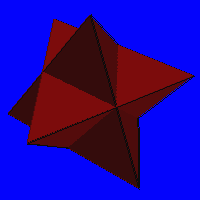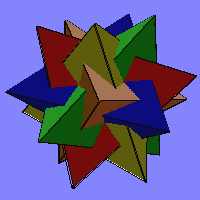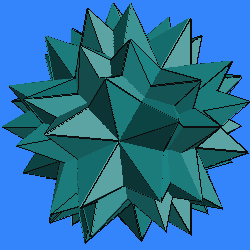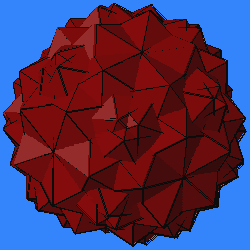Compounds of Polyhedra
- Many compounds are a combination of a solid with its dual. These are listed elsewhere with the Archimedean duals, the dipyramids and trapezohedra, and the nonconvex uniform polyhedra.
- The second type of compound is an interpenetrating set of several copies of the same polyhedron. That is what this page introduces.
 The
simplest example is the compound
of two tetrahedra, called the stella octangula by Kepler. This
one case is unique in that it falls under both of the above classes, because
the tetrahedron is the only self-dual uniform polyhedron. The edges of
the two tetrahedra form the diagonals of the faces of a cube in which this
compound can be inscribed. Here is a model of the two
tetrahedra inscribed in a cube, and here is just one tetrahedron
inscribed in a cube.
The
simplest example is the compound
of two tetrahedra, called the stella octangula by Kepler. This
one case is unique in that it falls under both of the above classes, because
the tetrahedron is the only self-dual uniform polyhedron. The edges of
the two tetrahedra form the diagonals of the faces of a cube in which this
compound can be inscribed. Here is a model of the two
tetrahedra inscribed in a cube, and here is just one tetrahedron
inscribed in a cube.
Another example, as described in the introduction, is the compound of five cubes inscribed in a common dodecahedron. One important Platonic relationship is that a cube can be inscribed in a dodecahedron. There are five different positions for the cube within that dodecahedron; superimposing all five gives the compound. Their intersection is a rhombic triacontahedron.
From the above two ideas, we know a tetrahedron can be inscribed in a cube two ways, and the cube, in turn, can be placed five times in a dodecahedron. This suggests inscribing tetrahedra in a dodecahedron. If we replace each of the five cubes inscribed in a dodecahedron with the two tetrahedra of its stella octangula, we get a compound of ten tetrahedra inscribed in a dodecahedron.
 If
instead we properly choose just one tetrahedron from each cube, we get
a compound of five tetrahedra
inscribed in a dodecahedron. This is not a mirror-symmetric object,
so it has an enantiomorph which you can see
by looking at your screen in a mirror. Here is the same five
tetrahedra in five different colors.
If
instead we properly choose just one tetrahedron from each cube, we get
a compound of five tetrahedra
inscribed in a dodecahedron. This is not a mirror-symmetric object,
so it has an enantiomorph which you can see
by looking at your screen in a mirror. Here is the same five
tetrahedra in five different colors.
Exercise: Before exploring inside, imagine what the intersection of the five tetrahedra is.
Answer: It looks like this,
where I have colored the faces according to the five colors of the five
tetrahedra.
Another important compound is formed by taking the dual of the compound of five cubes in a dodecahedron. The dual to one cube inscribed in a dodecahedron is one octahedron circumscribed around an icosahedron. In the original, we have eight of the dodecahedron's vertices selected as the cube's vertices. So in the dual, we have eight of the icosahedron's faces centered in the octahedron's faces. Repeating this dual construction for the five possible ways that a cube can be inscribed in a common dodecahedron gives a compound of five octahedra surrounding a common icosahedron. Here is the same thing in five colors, which emphasizes the individual octahedra. By duality, because the compound of five cubes has the same face planes as the rhombic triacontahedron, the compound of five octahedra has the same 30 vertices as the icosidodecahedron.
A second method of deriving this compound is to start with a model of one octahedron inscribed in a dodecahedron and realize that there are five different ways of placing it there. (The octahedron touches six of the thirty dodecahedron edges; there are five ways to choose which six.) Superimposing all five gives the compound. Perhaps this derivation is more direct, but the previous method makes clear that the interior of this compound is an icosahedron.
As a third derivation, start with the compound of five tetrahedra in a dodecahedron, shown above. Then recall that the midpoints of a tetrahedron's edges define an octahedron's vertices, and replace the five tetrahedra with their inner octahedra.
Exercise: In the compound of five octahedra, won't there be 40=5*8 faces for the interior? So how could the interior be an icosahedron, which we know has only 20 faces ?
Answer: Answer.
Six interesting compounds with octahedral symmetry can be made by combining two copies of a regular solid that has icosahedral symmetry. Imagine rotating the model of a cube inscribed in a dodecahedron by 90 degrees about one of the 4-fold axes of symmetry of the cube. This leaves the cube unchanged but puts the dodecahedron into a new position---a second dodecahedron circumscribed around the same cube. Combining these two dodecahedra gives the compound of two dodecahedra. The compound has octahedral symmetry even though the two parts individually have icosahedral symmetry. Observe that eight of the compound's vertices are the vertices of the original cube, while the remaining 24 vertices of the compound lie in the face planes of a larger cube.
Taking the dual to the above gives the compound of two icosahedra. An alternate method of deriving it is to begin with the icosahedron inscribed in an octahedron and realize that a second icosahedron can be inscribed in the same octahedron. Note that eight pairs of icosahedra faces are coplanar (at the faces of the octahedron), dual to the fact that eight pairs of dodecahedra vertices were coincident (at the cube's vertices).
Because each of the four Kepler-Poinsot solids have the same vertices as either the dodecahedron or the icosahedron, we can substitute them in to one of the these two compounds and get four additional compounds: two great dodecahedra, two great icosahedra, two small stellated dodecahedra, two great stellated dodecahedra. Paper models and face patterns for the last two of these are shown in Wenninger's Dual Models, listed in the references.
 Six
beautiful compounds with icosahedral symmetry can be made by combining
five copies of a regular solid with icosahedral symmetry. One method of
understanding these is as follows. Recall from above how two
different dodecahedra can be circumscribed around a cube, and also
think of the compound of five cubes
in a dodecahedron. That dodecahedron is one of the two that can be
circumscribed around each of the five cubes. Take the other dodecahedron
for each of the five cubes and they form a compound
of five dodecahedra. Take its dual to get a compound
of five icosahedra.
Six
beautiful compounds with icosahedral symmetry can be made by combining
five copies of a regular solid with icosahedral symmetry. One method of
understanding these is as follows. Recall from above how two
different dodecahedra can be circumscribed around a cube, and also
think of the compound of five cubes
in a dodecahedron. That dodecahedron is one of the two that can be
circumscribed around each of the five cubes. Take the other dodecahedron
for each of the five cubes and they form a compound
of five dodecahedra. Take its dual to get a compound
of five icosahedra.
It can also be derived from the compound of five octahedra circumscribed around an icosahedron. Recall that two different icosahedra can be inscribed in an octahedron, so for each of the five octahedra, take the other icosahedron from the one which is their common intersection. As a third method, use the fact that an icosahedron can be inscribed in a cube, and place one (properly) in each of the cubes in the compound of five cubes.
Using the Kepler-Poinsot solids in their places gives compounds of five great dodecahedra, five small stellated dodecahedra (shown at right), five great icosahedra, and five great stellated dodecahedra.
An alternate method of deriving these six compounds is indicated below. Three of these are illustrated in Wenninger's Dual Models, along with their face patterns: the five dodecahedra, five small stellated dodecahedra, and five great stellated dodecahedra.
 We
can also make interesting compounds of six regular solids with icosahedral
symmetry by the following method. Superimpose six copies of a dodecahedron
exactly on top of each other and imagine each one of its six axes of 5-fold
symmetry as being attached to one of the six dodecahedra. Now turn each
axis by 36 degrees (so the directions of the vertices and edge midpoints
of a pentagon are interchanged) and with it, one of the dodecahedra. The
result, which still has icosahedral symmetry, is the compound
of six dodecahedra. Take the dual of each component to get the compound
of six icosahedra. The reason for turning exactly 36 degrees is that
the planes of symmetry about a 5-fold axis are 36 degrees apart, and the
component must provide planes of symmetry there in order for the compound
to have icosahedral symmetry.
We
can also make interesting compounds of six regular solids with icosahedral
symmetry by the following method. Superimpose six copies of a dodecahedron
exactly on top of each other and imagine each one of its six axes of 5-fold
symmetry as being attached to one of the six dodecahedra. Now turn each
axis by 36 degrees (so the directions of the vertices and edge midpoints
of a pentagon are interchanged) and with it, one of the dodecahedra. The
result, which still has icosahedral symmetry, is the compound
of six dodecahedra. Take the dual of each component to get the compound
of six icosahedra. The reason for turning exactly 36 degrees is that
the planes of symmetry about a 5-fold axis are 36 degrees apart, and the
component must provide planes of symmetry there in order for the compound
to have icosahedral symmetry.
The idea, due to Michael Harman, can be applied to other symmetry axes. Ten copies rotated 60 degrees about the 3-fold axes gives a compound of ten dodecahedra and a compound of ten icosahedra.
If one tries to do this one more time, and rotate fifteen copies each 90 degrees about a 2-fold axis one does not get a new compound. Because the fifteen 2-fold axes come in five mutually orthogonal sets of three, groups of three rotated copies will coincide and the result is the compound of five dodecahedra or five icosahedra already listed above.
 In
addition to the well known compound
of five cubes, there are many other compounds of cubes, for example
this uniform compound of 3 cubes. For
more compounds, read about
In
addition to the well known compound
of five cubes, there are many other compounds of cubes, for example
this uniform compound of 3 cubes. For
more compounds, read about
- the different types of compounds of cubes,
- uniform compounds,
- Harman's compounds, and
- spinning compounds.